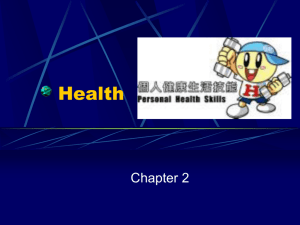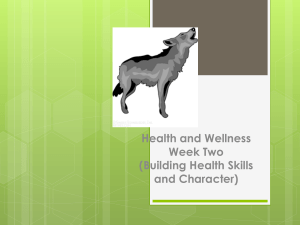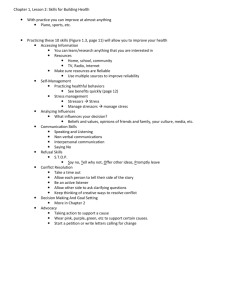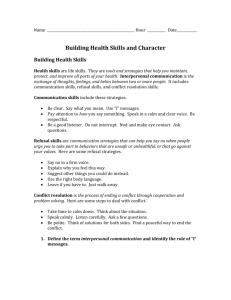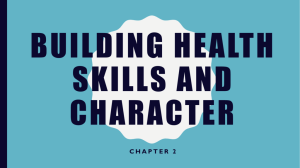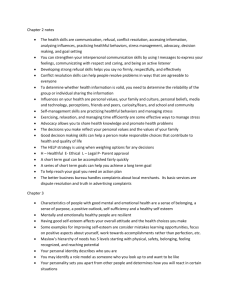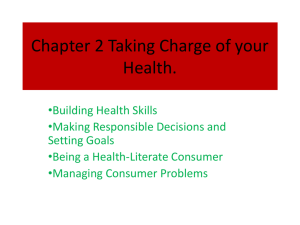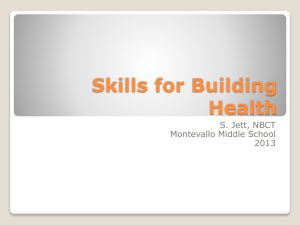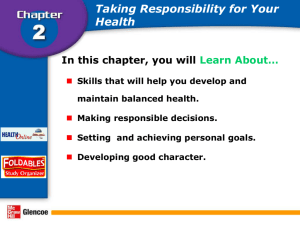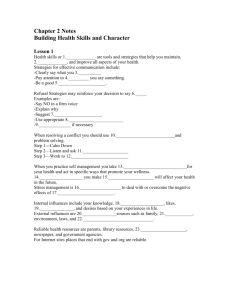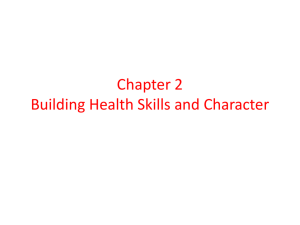Building Health Skills Chapter 2 Lesson 1
advertisement
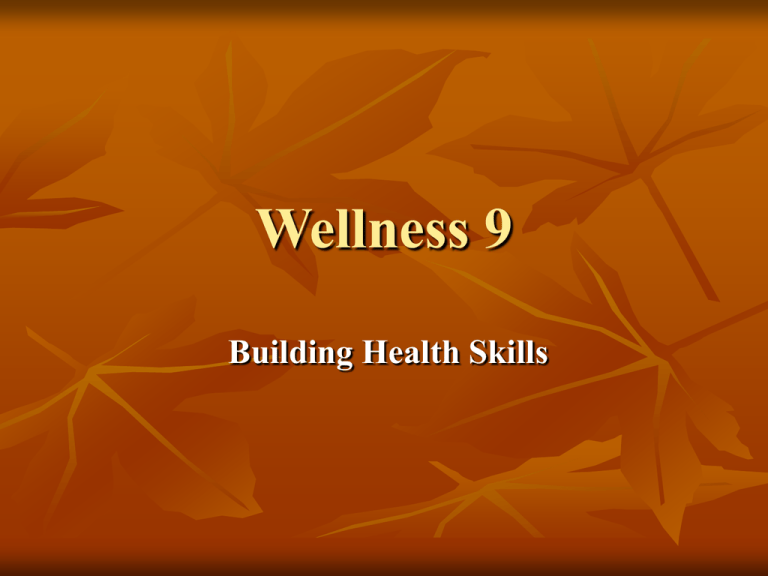
Wellness 9 Building Health Skills Instant Activity List the skills and qualities necessary for effective communication. Explain how having strong communication skills can impact your health in positive ways. Objective Students will identify the specific tools and strategies that help maintain, protect, and improve all aspects of your health. Health Skills/Life Skills Specific tools and strategies that help you maintain, protect, and improve all aspects of your health. Physical, Mental/Emotional, Social The Six Health Skills Health Skills/Life Skills 1. Interpersonal Communication - Communication Skills - Refusal Skills - Conflict Resolution 2. Self Management - Practicing healthful behaviors - Stress Management 3. Analyzing Influences 4. Accessing Information 5. Decision Making/Goal Setting 6. Advocacy Interpersonal Communication The exchange of thoughts, feelings, and beliefs between two or more people Effective communication skills: Clearly say what you mean. Use “I” messages to state your position Pay attention to how you say something (respectful tone, facial expressions, gestures) Be a good listener. Avoid interrupting and show you are listening (nod, asking questions) Refusal skills: communication strategies that can help you say no Conflict resolution: the process of ending a conflict through cooperation and problem solving Steps when dealing with a conflict: Take time to calm down and think through the situation When discussing the conflict, speak calmly, listen, and ask questions Use polite tone and brainstorm solutions to resolve the conflict peacefully Five effective refusal strategies What are refusal skills? Communication strategies that can help you say no when you are urged to take part in behavior that are unsafe or unhealthful, or that go against your personal beliefs. Say no in a clear and firm voice: expressions such as “I’d rather not.” Explain why: state that the suggested activity goes against your personal values. Suggest alternatives: propose a safe healthy activity to do instead. Use appropriate body language: look directly into their eyes and do not back down from your position. Leave if necessary: if the other person continues to pressure you, just walk away. Conflict resolutions skills Conflict resolution is the process of ending a conflict through cooperation and problem solving. The key to conflict resolution is respecting others’ right and your own. Willingness to compromise will also help achieve a resolution that satisfies everyone. Take time to calm down and think through the situation. When discussing the conflict, speak calmly and listen attentively asking questions when appropriate. Use a polite tone and try to brainstorm where no one loses respect. Activity: Cooperation learning activity (pg. 30) Self Management Two self management skills, practicing healthful behaviors, and managing stress helps provide a foundation of good health Practicing healthful behaviors: Help to protect you from illness or injury Eat nutritious foods Get regular medical and dental check-ups Avoid the use or tobacco, alcohol, and other drugs Express your feelings Build your self-esteem Maintain healthy relationships Stress management: ways to deal with or overcome the negative effects of stress Stress management becomes more important as you take on more responsibility for your health and additional roles as an adult Ex: physical activity, listening to music, managing time effectively, laughing Analyzing Influences Showing a variety of influences. Show both internal and external influences. Explain the complexity of the influences. Show how the influences affect health choices. Accessing Information Learning how to find and recognize trustworthy information will help you be better prepared to make healthful choices Reliable sources: Parents, guardians, and other trusted adults Library resources such as encyclopedias and nonfiction books Reliable Internet sites such as those posted by government and educational institutes Newspaper and magizine articles by health professionals or experts Government agencies, health care providers, and health organizations Decision making/Goal Setting Steps that enable you to make a healthful decision Steps that help you to protect your rights and health as well as the rights and health of others Steps of the decision making progress: Step 1: State The Situation Step 2: List The Options Step 3: Weigh The Possible Outcomes Step 4: Consider Values Step 5: Make A Decision And Act On It Step 6: Evaluate The Decision A goal is something that you aim for that takes planning and work There are two different types of goals: short-term (over a short period of time) and long-term (over a long period of time) To establish your goals, Advocacy Taking a clear stand for a healthy choice. Being persuasive. Explaining why the stand taken is good for health. Use information to support the choice. Show awareness of the audience for the message Show conviction about the message
